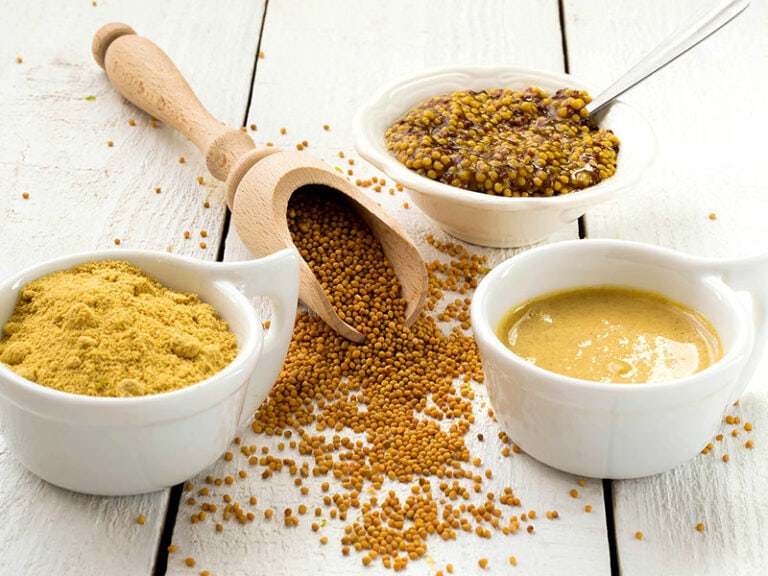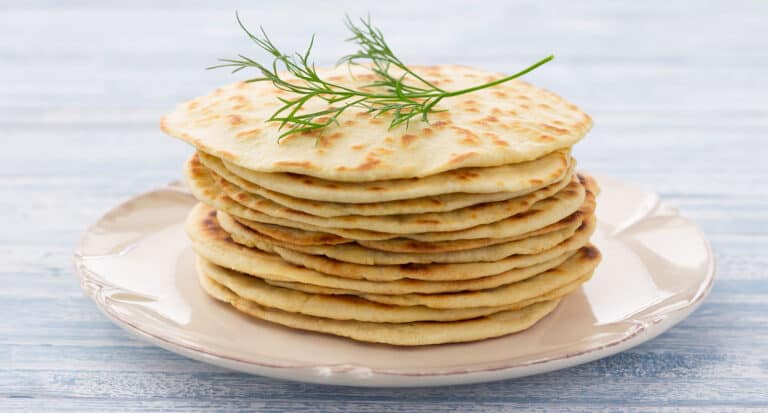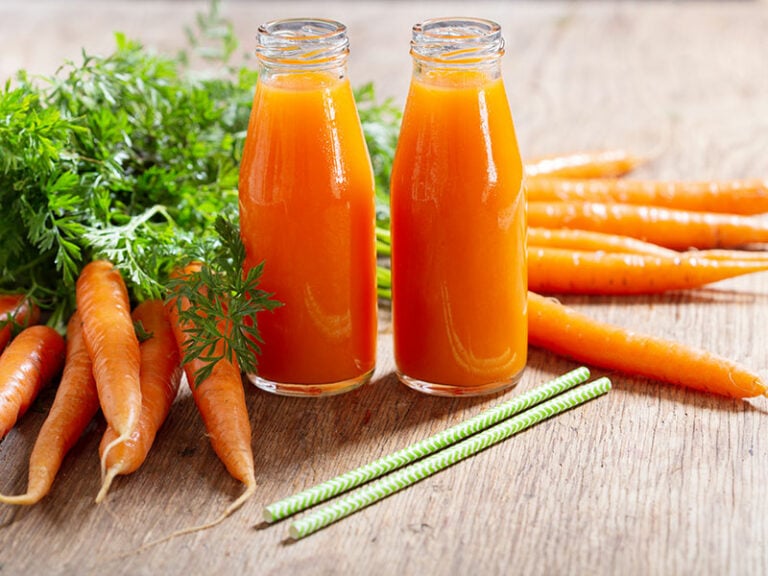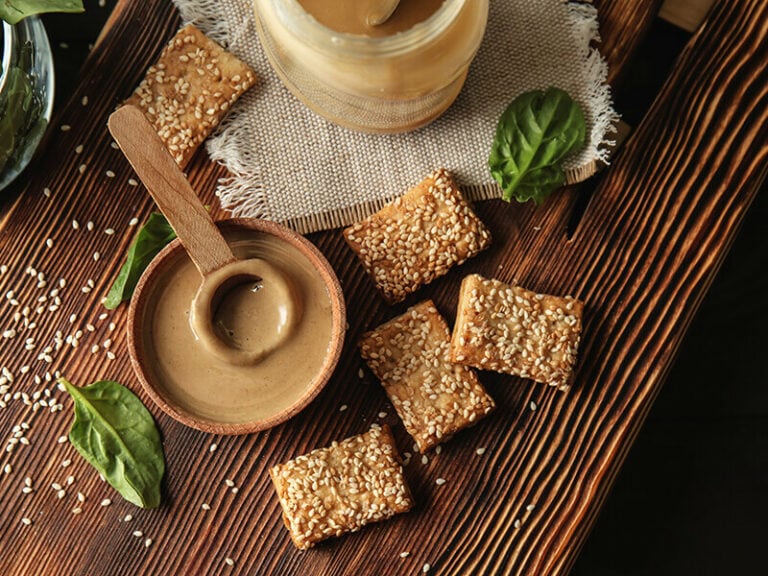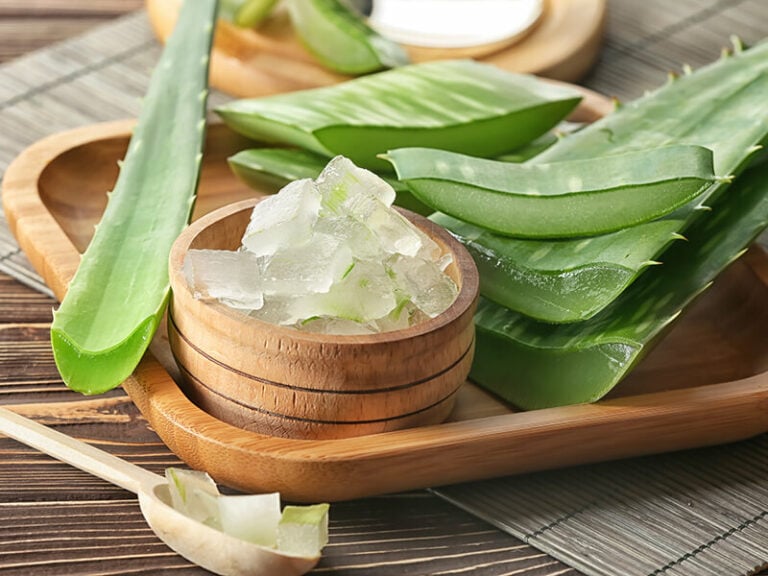“How to tell if zucchini is bad?” The skill of choosing good ingredients for your dishes is essential and the same as how to select zucchini.
Zucchini is a very popular fruit starting with Z for growing and harvesting at home or buying from the supermarket for processing. However, you do not always notice the signs that the zucchini has turned bad, so you may choose to hit the bad one.
Today, I’ll show you how to tell when they’re getting bad and less delicious.
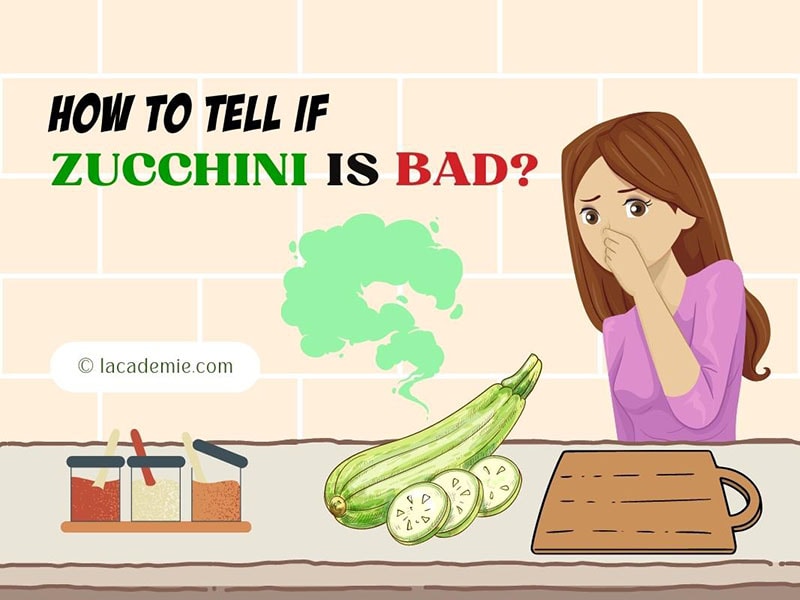
Zucchini Identity
Zucchini can be called either zucchini squash or zucchini fruit. This fruit is a summer squash and a convolve plant. Different zucchini varieties are available in different colors, such as deep green, light green, yellow, or orange.
Its mature size is 1 meter, but they usually harvest it when it is about 15 to 25 cm. At that time, zucchini is still young; the flesh is firm, meaty, provides a mild sweet taste and a hint of bitterness; even the skin and immature white seeds are edible.
Cooked zucchini has a much milder flavor that will not overpower the main ingredients. Thus, people often add it to bread or cake, like some dishes using buttermilk. This zucchini will help moisten the center after baking.
And the cucurbitacin compounds inside the zucchini lead to bitterness. Although zucchini is naturally bitter, the volume is relatively mild. If you can taste the strong bitterness from your zucchini, you should stop eating and toss it away.
Because the increased cucurbitacins can cause severe stomach upset, diarrhea, or poisoning.(1) That’s one of the reasons why you should know how to detect if your zucchini goes bad or not.
Signs That Zucchini Goes Bad
Zucchini is a perishable fruit, and it is pretty quickly wilted even if you have a fresh one from your garden or at the supermarket. Fortunately, there are several detectable signs to check this food whose name begins Z’s quality. Let’s find out now!
1. Appearance
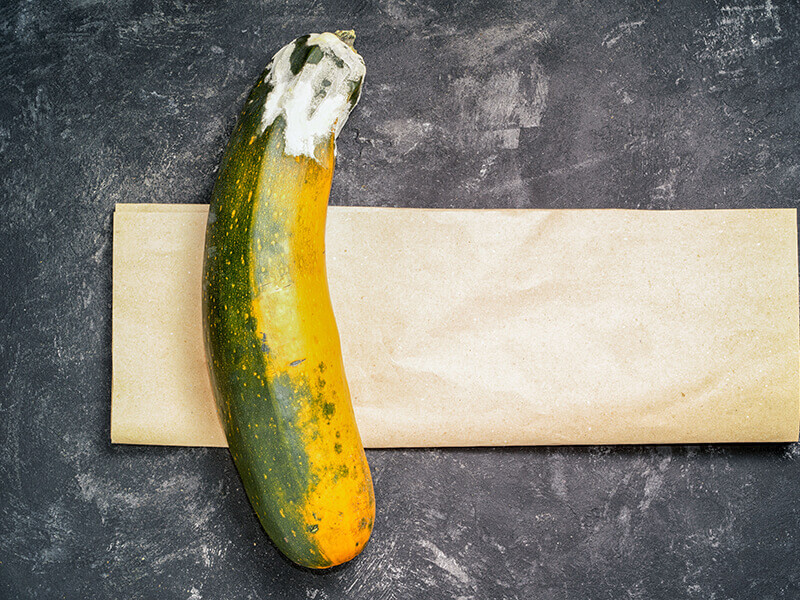
The most significant signs might be the changes in appearance. The fresh zucchinis probably have shiny skins. Therefore, you should avoid ones that have rotten spots and decay or moldy parts on the skins.
If the decay or black spots are small, you can cut them out and use the rest. But if the rotten parts are widespread, you have no choice but to throw the whole fruits away.
There are also some wrinkles or shrivels that start to appear on their beautiful skins. These are the signs that the inside might be rotten, and the zucchini is getting older, and you should discard them.
2. Texture
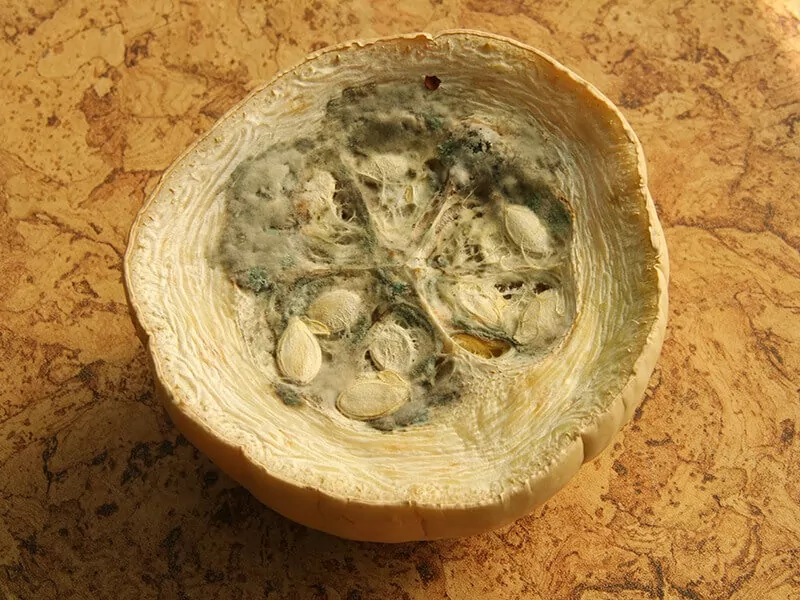
The bad zucchinis are mushy and soft, which can easily detect when you touch them. You can cut them out to check. If their insides are stringy, spongy, fibrous, or spoiled with an unpleasant smell and filled with hard, big mature seeds, you should toss them out.
You cannot use zucchinis if they are getting stringy or fibrous because they usually contain moisture and will become useless and tasteless when they change their texture.
In the worst cases, they even turn pulpy and release the white milk-looking, stingy liquids. Otherwise, if the mushy parts are small or shallow and you can still remove them, the remaining fresh rest is still usable.
It is slightly rubbery but not very soft; it is still usable in cooked dishes like soups, stews, or baking goods. When your zucchinis are a bit older, they shouldn’t be served raw anymore.
3. Smell
The fresh zucchini has a lovely “veggie” smell, not robust. Once it’s getting worse, you can smell the strange vinegar-like or sour-fermented scent. This is another sign to toss the bad zucchinis away.
4. Taste
It is best to detect your bad zucchini before cooking and trying, but sometimes their appearances and textures don’t change much, even when they are getting wilted and older. At that time, you should notice the taste.
As I mentioned, the zucchini is famous for its light bitterness from the cucurbitacins; signature compounds exist in the cucumber family. A small amount in young fruits cannot affect your health.
But once the fruits are older, or unfortunately, affected by the intercropping technique, the dose of this substance is higher than usual. You should consider tossing it away before causing any health problems.(2)
Therefore, to check the taste, you should cut a bit of the zucchini off and lick. If there is a sharp bitterness in your tip tongue, your zucchini is bad.
Signs That Zucchini Goes Bad In The Garden
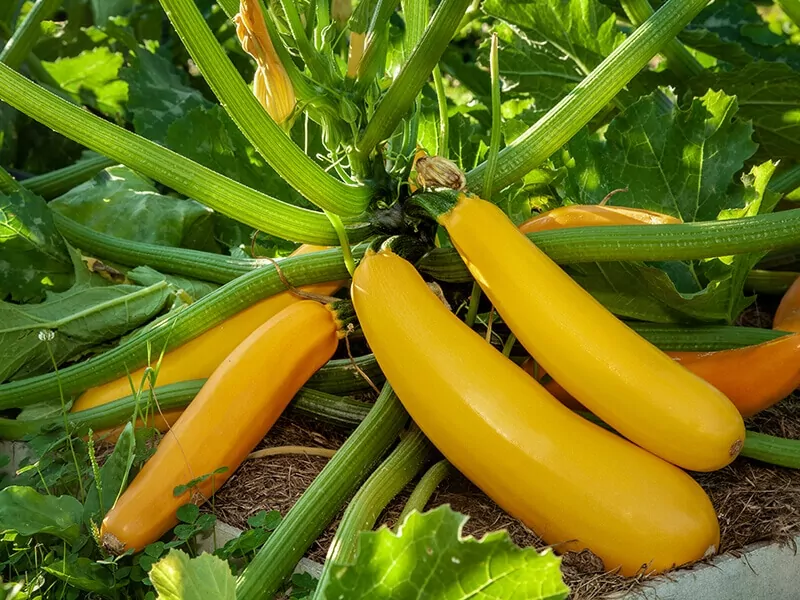
Besides these 4 signs above that can help you to avoid bad zucchini generally, how to know if the zucchini in your garden is good or bad? If you have a small garden of zucchini, you should remember some signs below.
5. Late Harvesting
You must harvest zucchini young and immature. It’s harder to know when you bought your zucchini, but it’s much easier to know if you grow and harvest it yourself.
The standard zucchinis to harvest should be 15 to 25 cm ( 6 – 8 inches) in length, and the plants have an age of around 40 to 60 days. As for the fruits, their ages will be at about 35 days or sooner, so you need to observe frequently.
Late harvesting or leaving it in the garden for so long can lead to the loss of taste, harder flesh and start to deteriorate.
6. Blossom-End Rot
This problem might be caused because of over-fertilization, uneven watering, and lack of pollination (bees and other pollinating-support insects cannot be active when the weather is bad like rainy or stormy).
The sign is very significant; the rotten spots appear on the fruits while still on the plants. If it is the case, your zucchinis from that plant might contain too much nitrogen and lack calcium.
You should skip these fruits and change how to take care of your zucchini plants for the next harvest.
This video will show you when and how to harvest zucchinis properly from your garden:
Pocket Tips To Choose Good Zucchini
Zucchini provides massive health benefits, and consuming not-as-fresh ones might bring contrast effects. Also, knowing how to choose the perfect zucchinis helps you save money, time (on choosing wilted ones) and extend the shelf life of your gourds.
1. Sizes
The sizes of zucchinis really matter the quality of the fruits. It’s best to choose ones that are 15 to 25 cm or 6 to 8 inches long (as I mentioned). The bigger the zucchinis are, the older they are, and there are more chances to hit unwanted spongy, plain flesh gourds.
2. Stems
Choose the fruits with fresh stems attached, the stems might help them to preserve their freshness longer and also a sign that the produce are freshly harvested.
3. Perfect Skins
It would help if you chose the zucchini with clean skin, no marks, no black spots, or discoloration. The zucchini still has tiny white hair left on the skin is the best; it will have the perfect mild sweetness and the milky white, buttery meat inside.
4. Texture
You should try to check their firmness by holding and squeezing them gently in your hands. If they are firm enough that you can feel the slight resistance, then that squash is fresh enough.
How To Store Zucchini
There are many ways to store zucchini: At room temperature, in the fridge, or even in the freezer. Now I will guide you on the easiest methods to keep your zucchini.
At Room Temperature
When you want to keep your fresh zucchinis at room temperature, you need to focus on something below:
- Put them in a cool, dry place for storing.
- Don’t wash them or cut them out.
It is pretty easy to store your zucchini at room temperature, and of course, it won’t last for too long, only 3 to 4 days. This expiry date can be extended to 5 days if you store it avoiding direct sunlight.
Check your fruit’s condition frequently, if you see it is starting to soft, use it cooked, not raw.
In The Fridge
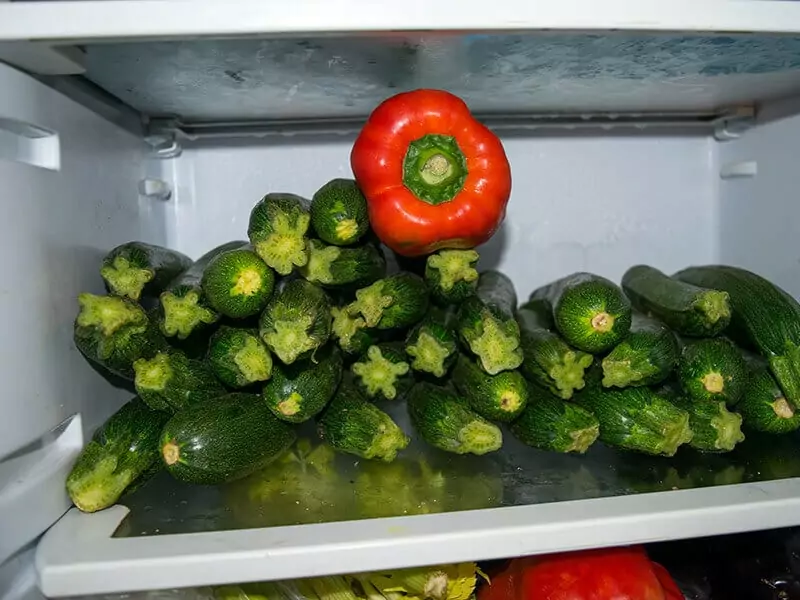
The ideal temperature to store zucchini is about 41 or 50 degrees F (equals 5 degrees C), which is a bit higher than the average temperature at 40 degrees F in the fridge.(3) Therefore, you can consider some notes here:
- As usual, don’t wash your zucchini before storing it. Excess moisture might lead to mushy and wilted zucchini.
- Keep them as a whole, and don’t cut them out.
- Put your veggie in the crisper drawer, vegetable drawer, or on the fridge door. These places might be the warmest place in your fridge.
Following the notes can help you to have whole fresh zucchinis for one or two weeks ahead.
If you want to prepare your zucchini, after cutting them into cubes, slices, or strips, you should put them into an airtight bag and put the bag into the veggie drawer. (You shouldn’t wash them.)
Your pre-cut zucchinis only last 2 or 3 days in the fridge, so ensure to cook them after a day or two. This applied the same to cooked zucchini.
Best Way To Freeze Zucchini
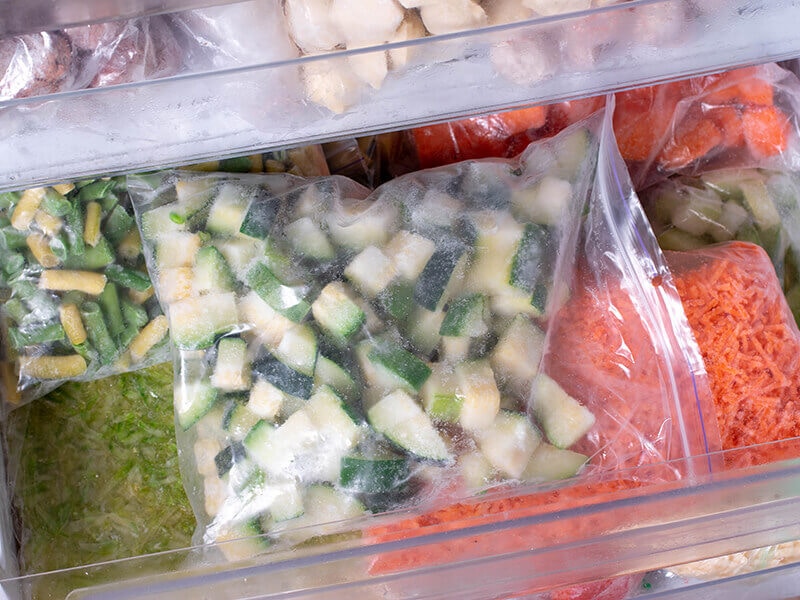
Freezing zucchinis can help you store them for up to 3 or 12 months. But different from the two previous methods, you need to prepare some more steps.
Step 1: Slide your zucchinis into ½ inch round slices / or strips (it’s okay).
Step 2: Blanch them quickly in hot unsalted water for one minute.
Step 3: Quickly drain them out and put your “zucchini coins” into ice water. Wait for them to cool down before moving on to the next step.
Step 4: Use the paper towels to take as much excess water out of the zucchinis’ surface to avoid icing and freezer burn.
Step 5: Spread a layer of your zucchinis evenly on a tray, put them into the freezer to pre-freezer until they are getting harder.
Step 6: Once your zucchinis are dry and cold enough, take them out of the tray and put them into some containers that are freezer-safe or resealable bags. Remember to squeeze out as much air as possible and place them in the freezer.
Although this method can keep your zucchini usable for up to 12 months, you should use them in 2 or 3 months to have the best results and reduce the chance of loss in taste.
Ultimate guidance on how to freeze zucchinis. Watch this video to know:
This table might help you get a brief review on how to store zucchinis and choose your most preferable ways.
Suggested Ways To Deal With Zucchini Before It Goes Bad
Having too many zucchinis, and now you are out of ideas to deal with it? You can consider some recipes below.
Zucchini Bread
Low in calories, made of super nutritious ingredients, and so easy to make, this is a perfect breakfast for you. If you are stuck on how to use up your zucchinis, you should try this recipe.
Pickled Zucchinis
Pickled zucchinis are not only delicious, but it is also an intelligent way to store your veggie. The shelf life of pickled zucchinis is up to 2 years in the fridge.
It is not a bad idea to make a whole big jar of pickles, and you can have a yummy accompaniment for your sloppy joes, hamburger, toast, or sandwich in the next few years. Believe me; this recipe is so delicious that your pickles will not last too long.
Making a perfect jar of pickled zucchinis has never been this easy. Watch this video:
Vegetable Lasagna
This healthier version of lasagna can blow your mind. This vegetable lasagna is a perfect combination in the taste and texture of various fresh veggies, and you might not know that it is super mouth-watering. Try this once, and you cannot stop making it every Friday night.
FAQs
Do you have any other questions for me about zucchini? In case there are, below are some frequently asked questions that you might have the same.
Enjoy Your Zucchini Fresh And Delicious
No more worries on how to tell if zucchini is bad; now you have some valuable tips to check the condition of your zucchini.
If you have a lot of zucchinis on hand and don’t know how to deal with it, trying my suggestion on how to store them or some interesting recipes I have recommended is not a bad idea.
Feel free to contact me and leave the comment below if you have anything to share. Your contributing comments will be a huge motivation for me.
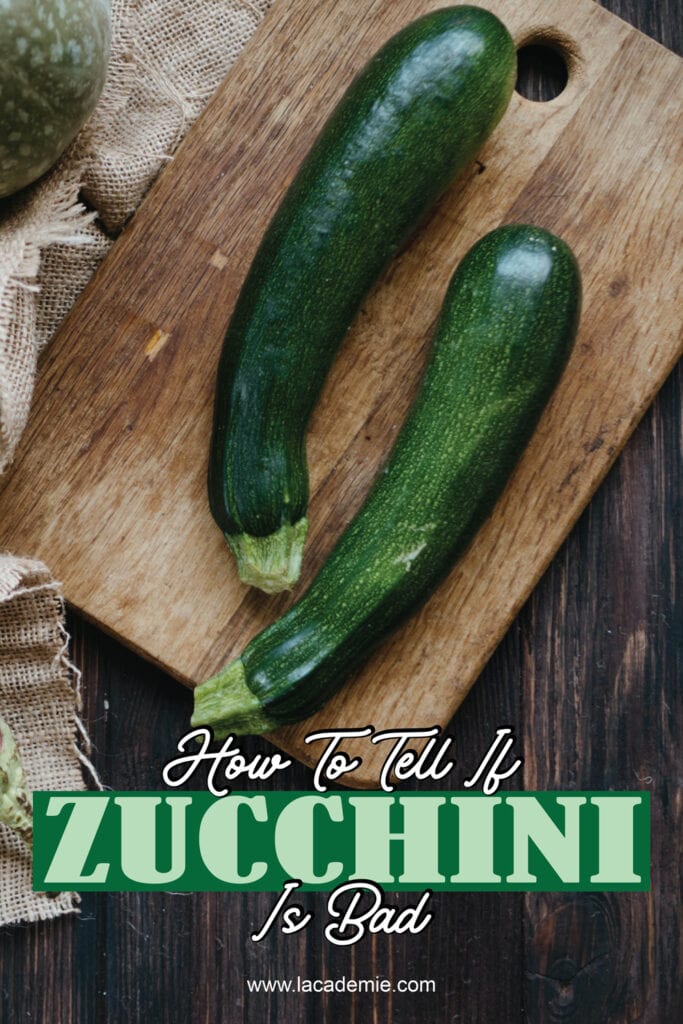
References
1. American Chemical Society. 2021. Cucurbitacins – American Chemical Society.
2. En.wikipedia.org. 2021. Zucchini – Wikipedia.
3. Cde.state.co.us. 2021.
4. Healthline. 2021. 12 Health and Nutrition Benefits of Zucchini.
5. Lybrate. 2021. Benefits of Zucchini And Its Side Effects | Lybrate.

